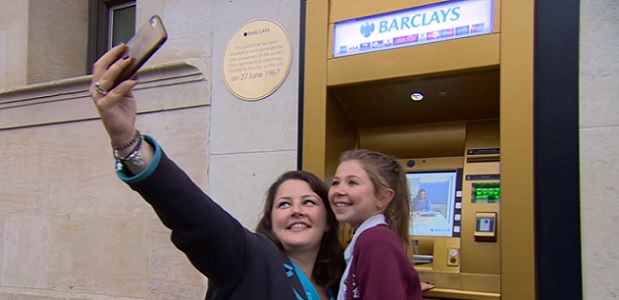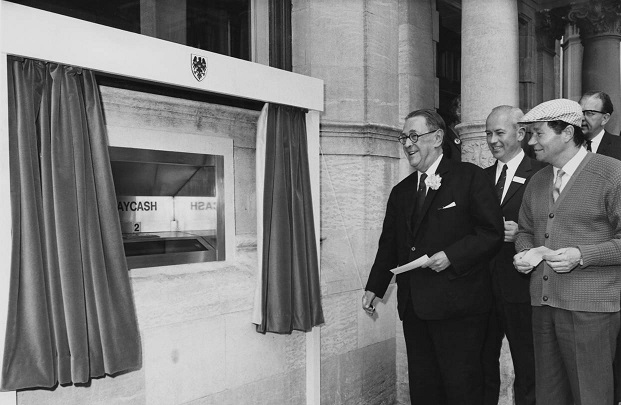
On June 27, 1967, a Barclays Bank branch in London unveiled the world’s first automated cash dispenser later known as an Automated Teller Machine. This device was invented by John Shepherd-Barron and his team at De La Rue Instruments Ltd. It solve a common problem: in much of the world, cash could be obtained only when a bank was open, typically weekdays between about 10 a.m. and 3 p.m., known as “bankers hours”. The limited schedule often meant long lines. And it could be difficult, if not impossible, to obtain money from a bank other than your own.
The engineer John Shepherd-Barron, said that his “aha” moment was a byproduct of arriving at his bank one minute after it closed. “That night I started thinking that there must be a better was put in a slot and a bar dispatched. Surely money could be dispensed in the same way.”

Photo: Sir Thomas Bland, Deputy Chairman of Barclays Bank, unveils the first Barclayscash machine in London
The first ATM had limited functionality; it neither accepted deposits nor dispensed more than £10 (then worth $28) at a time. Still, ATM’s quickly gained popularity. They were convenient and thus contributed to customer loyalty, and they helped reduce bank operating costs.
Two other independent machines were also deployed in 1967 (1) . One in Uppsala, Sweden, designed by AseaMetior (today ABB) at the behest of the Swedish savings banks. This machine was called Bankomat. A second device was engineered by Chubb for the Westminster Bank (today RBS Group) in London.
(1) In the patent record, the roots of the modern ATM is attributed to Luther Simjian’s Bankmatic, which is described in the US002930296 patent of 1960 and cited as „prior art device” by all subsequent submissions. The Bankmatic was a depositaccepting machine which produced a photograph as a receipt. One of these devices was put to the test in the lobby of a branch of Citibank in New York in 1961, a kind of night safe device. A second early development took place in Tokyo, Japan. Little is known of the Japanese device. In any case neither Simjian’s nor the Japanese technology ever took off.
The year 1969 saw the arrival of other independent manufacturers notably Speytec (later to be part of Detroit-based Burroughs) in the UK, Omron-Tateishi in Japan, and Docutel and Diebold in the USA. The trend continued during the early-to-mid 1970s to include IBM, which in 1973 entered the market deploying an online machine which followed specifications by Lloyds Bank (2) and later NCR.
(2) The claim to the first online cash dispenser is challenged by the Swedish Bankomat and Japanese Omron – Tateishi.
In 1969 the ATM crossed the Atlantic. A Chemical Bank branch in Rockville, N.Y., announced in a newspaper advertisement: “On Sept.2 our bank will open at 9.00 and never close again.”
Later, the ATM went online when machines were connected in expanding inter-bank networks(which reached 200 in number in the USA alone), while card associations like Visa and MasterCard created international card networks for debit and credit card use. This meant ATMs could be used both at interbank and at cross-border level. The uptake of cash dispensers really took off during the 1980s and 1990s. NCR, Diebold and Nixdorf (today Wincor Nixdorf3 ) became the world’s leading manufacturers.
By 2015 there were 3.2 million ATMs world-wide, and they’re found on all seven continents, including Antarctica. They’ve become part of the fabric of life – one company has sold ATM Hallowen costumes – while helping to spur a self-service culture that’s been extended to gas stations and airport check-ins. Globally, there were close to 100 billion ATM transactions in 2015, and $13.2 trillion in withdrawals. For the U.S. alone, these figures were 5.8 billion and $700 billion.
Paul Volcker, a former Federal Reserve Chairman, quipped in 2009 that “the most important financial innovation that I have seen the past 20 years is the automatic teller machine”. And like any great product, the ATM has had to evolve. No longer just cash machines, customers can use them to pay bills, get a new card, tap a line of credit, and even chat by video with a human teller hundreds of miles away. Some banks in India use their ATMs to extend loans in a matter of seconds.
Cash will remain a part of our day-to-day lives for decades, the Bank of England’s chief cashier has said on the 50th anniversary of the ATM. Victoria Cleland said that although the use of notes and coins in transactions is falling, cash is part of all the Bank’s future plans. She pointed out that 94% of UK adults use cash machines.
It was 50 years ago today that the world’s first ATM was unveiled at a Barclays branch in Enfield, London. As a tribute to the golden anniversary, Barclays has transformed the modern-day Enfield cash machine into gold (see photo).
Ms Cleland said that more than half of UK adults use an ATM at least once a week. Cash was used in nearly half of all transactions and was also important as a store of value, she added.
Raheel Ahmed, head of customer experience at Barclays, echoed Ms Cleland’s views.
„Even though recent years have seen a huge uptake of digital banking and card payments, cash remains a crucial part of most people’s day-to-day lives – whether it is paying for groceries or doing the office coffee run – and we’re very proud of the role that Barclays has played in the history of the cash machine.”, according to the BBC.
The first cash machine came about after some hurried signing of contracts, over a pink gin, between Barclays and Scottish inventor John Shepherd-Barron, who died in 2010.
„It struck me there must be a way I could get my own money, anywhere in the world or the UK,” he told the BBC in 2007. „I hit upon the idea of a chocolate bar dispenser, but replacing chocolate with cash.”
All did not go entirely to plan with the first ATMs. When one was installed in Zurich, Switzerland, there was a mysterious malfunction. Eventually, it was found that wires from two intersecting tramlines nearby were interfering with the mechanism.
There are now about 70,000 cash machines across the UK, and 176 million cards in the UK that can be used to withdraw cash at them. These cards were used to withdraw a total of £180bn from UK cash machines last year.
The latest developments aim to make the ATM a „bank branch in a box”. Manufacturer NCR said its research showed that 80% of the transactions typically completed inside a physical branch could be completed through a video teller at an ATM.
Portugal has the highest proportion of cash machines in western Europe with 1,516 machines per one million residents. Sweden, typical of a Scandinavian shift towards a cashless society, has the lowest with 333 machines per one million inhabitants.
„The ATM certainly changed the way we think and behave, both as individuals and as a society, and put us in control of our cash for the first time. Over time, we see that self-service devices like the ATM laid the groundwork for today’s range of digital retail financial services. New services and technology, such as biometric and anti-fraud solutions, are continuously contributing to the on-going innovation of the ATM, where security is far stronger than it is on laptops and cell phones.”, according to ATMIA.
What is the future of ATMs? “In addition to their ever-expanding capabilities in the physical world, they’re destined to provide an enhanced experience with augmented reality. At some point in the future, a visit to the ATM may include capturing the most-soughr-out Pokemon while taking out cash using a retinal “PIN”, says Bill Nuti, chairman and CEO of NCR Group.
Banking 4.0 – „how was the experience for you”
„To be honest I think that Sinaia, your conference, is much better then Davos.”
Many more interesting quotes in the video below: